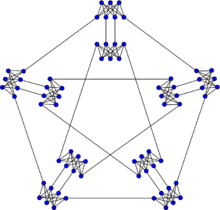Meredith graph
| Meredith graph | |
|---|---|
 The Meredith graph | |
| Named after | G. H. Meredith |
| Vertices | 70 |
| Edges | 140 |
| Radius | 7 |
| Diameter | 8 |
| Girth | 4 |
| Automorphisms | 38698352640 |
| Chromatic number | 3 |
| Chromatic index | 5 |
| Book thickness | 3 |
| Queue number | 2 |
| Properties | Eulerian |
| Table of graphs and parameters | |
In the mathematical field of graph theory, the Meredith graph is a 4-regular undirected graph with 70 vertices and 140 edges discovered by Guy H. J. Meredith in 1973.[1]
The Meredith graph is 4-vertex-connected and 4-edge-connected, has chromatic number 3, chromatic index 5, radius 7, diameter 8, girth 4 and is non-Hamiltonian.[2] It has book thickness 3 and queue number 2.[3]
Published in 1973, it provides a counterexample to the Crispin Nash-Williams conjecture that every 4-regular 4-vertex-connected graph is Hamiltonian.[4][5] However, W. T. Tutte showed that all 4-connected planar graphs are hamiltonian.[6]
The characteristic polynomial of the Meredith graph is [math]\displaystyle{ (x-4) (x-1)^{10} x^{21} (x+1)^{11} (x+3) (x^2-13) (x^6-26 x^4+3 x^3+169 x^2-39 x-45)^4 }[/math].
Gallery
The chromatic number of the Meredith graph is 3.
References
- ↑ Weisstein, Eric W.. "Meredith graph". http://mathworld.wolfram.com/MeredithGraph.html.
- ↑ Bondy, J. A. and Murty, U. S. R. "Graph Theory". Springer, p. 470, 2007.
- ↑ Jessica Wolz, Engineering Linear Layouts with SAT. Master Thesis, University of Tübingen, 2018
- ↑ Meredith, G. H. J. (1973). "Regular n-valent n-connected nonHamiltonian non-n-edge-colorable graphs". Journal of Combinatorial Theory, Series B 14: 55–60. doi:10.1016/s0095-8956(73)80006-1.
- ↑ Bondy, J. A. and Murty, U. S. R. "Graph Theory with Applications". New York: North Holland, p. 239, 1976.
- ↑ Tutte, W.T., ed., Recent Progress in Combinatorics. Academic Press, New York, 1969.
 |



